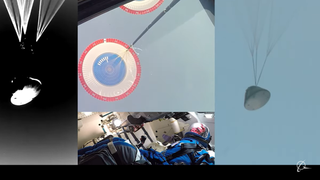Ride aboard Boeing's Starliner astronaut taxi as it returns to Earth in this video
The Boeing Starliner spacecraft is targeting astronaut taxi missions to the International Space Station in 2023, following a successful test mission.
We now know what spaceflight looks like from Boeing's new astronaut taxi.
Fresh footage from Boeing's uncrewed test flight of Starliner in May show several views of the spacecraft coming in for a landing at the end of Orbital Test Flight-2, which flew to the International Space Station and back.
Up to four cameras of Starliner's final flight minutes on May 25 play simultaneously in the video, which is uploaded on YouTube.
An interior view starring a mannequin, a view out the window, and two ground cameras supply multiple perspectives to provide engineers data about the landing effort in the New Mexico desert.
Related: Boeing's Starliner, a next-generation spaceship

"Starliner lands in the desert rather than splashing down in the ocean, which is a first for an orbital capsule built in the United States," Boeing officials wrote in a caption to the YouTube video, contrasting its design to competitor SpaceX that uses ocean landings.
"Its [Starliner's] proven parachute and airbag systems provide a soft landing on the sand, reducing the load on the crew," Boeing continued. "Without sea state considerations, like wave height, swells, currents and surface winds, passengers are able to step right out of the spacecraft onto dry land."
Get the Space.com Newsletter
Breaking space news, the latest updates on rocket launches, skywatching events and more!
The engineering information will be crucial to make sure that Starliner is ready for new astronaut missions. Boeing and NASA together are working through the data from the test flight to see how well the company did in meeting the objectives.
This process is expected to complete in the coming months, and Boeing hopes to launch its first crewed space mission in February 2023, which is a delay of three months due to addressing some issues in the test flight, according to past statements from Boeing and NASA.
Related: The science and cargo of Boeing's OFT-2 Starliner test flight to space station
Boeing has a commercial crew agreement with NASA to launch at least six missions to the orbiting complex through NASA's expected end of the international partnership in 2030. That said, other partners have not yet signed on for an extension to the ISS framework, which currently expires in 2024. (Russia plans to leave after 2024 to build its own space station.)
The other supplier of commercial crew flights, SpaceX, has been sending astronauts to the ISS since 2020. NASA recently awarded SpaceX more ISS flights, saying that right now, the Hawthorne, California-based company is the only one rated to send astronauts on orbital space missions from American soil.
A selection of crewed space flights still take place from Russia, which supplies Soyuz flights to the ISS. That said, NASA is pursuing most of its space missions independently, especially in the wake of Russia's internationally condemned invasion of Ukraine in February 2022. The countries have said repeatedly that operations between the United States and Russia remain normal when it comes to human spaceflight, even as other space agreements were torn up.
Follow Elizabeth Howell on Twitter @howellspace. Follow us on Twitter @Spacedotcom or Facebook.
Join our Space Forums to keep talking space on the latest missions, night sky and more! And if you have a news tip, correction or comment, let us know at: community@space.com.

Elizabeth Howell (she/her), Ph.D., is a staff writer in the spaceflight channel since 2022 covering diversity, education and gaming as well. She was contributing writer for Space.com for 10 years before joining full-time. Elizabeth's reporting includes multiple exclusives with the White House and Office of the Vice-President of the United States, an exclusive conversation with aspiring space tourist (and NSYNC bassist) Lance Bass, speaking several times with the International Space Station, witnessing five human spaceflight launches on two continents, flying parabolic, working inside a spacesuit, and participating in a simulated Mars mission. Her latest book, "Why Am I Taller?", is co-written with astronaut Dave Williams. Elizabeth holds a Ph.D. and M.Sc. in Space Studies from the University of North Dakota, a Bachelor of Journalism from Canada's Carleton University and a Bachelor of History from Canada's Athabasca University. Elizabeth is also a post-secondary instructor in communications and science at several institutions since 2015; her experience includes developing and teaching an astronomy course at Canada's Algonquin College (with Indigenous content as well) to more than 1,000 students since 2020. Elizabeth first got interested in space after watching the movie Apollo 13 in 1996, and still wants to be an astronaut someday. Mastodon: https://qoto.org/@howellspace
